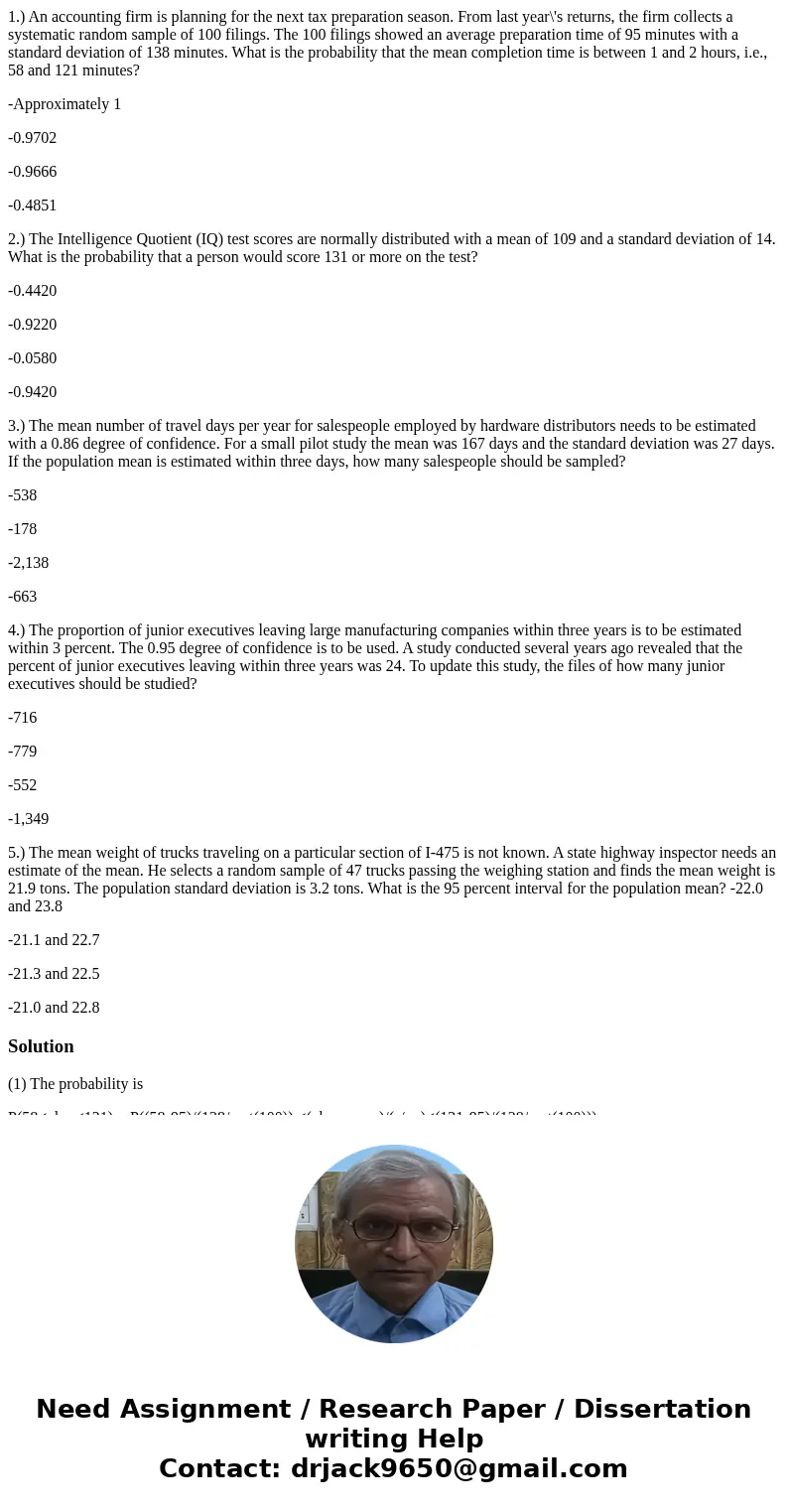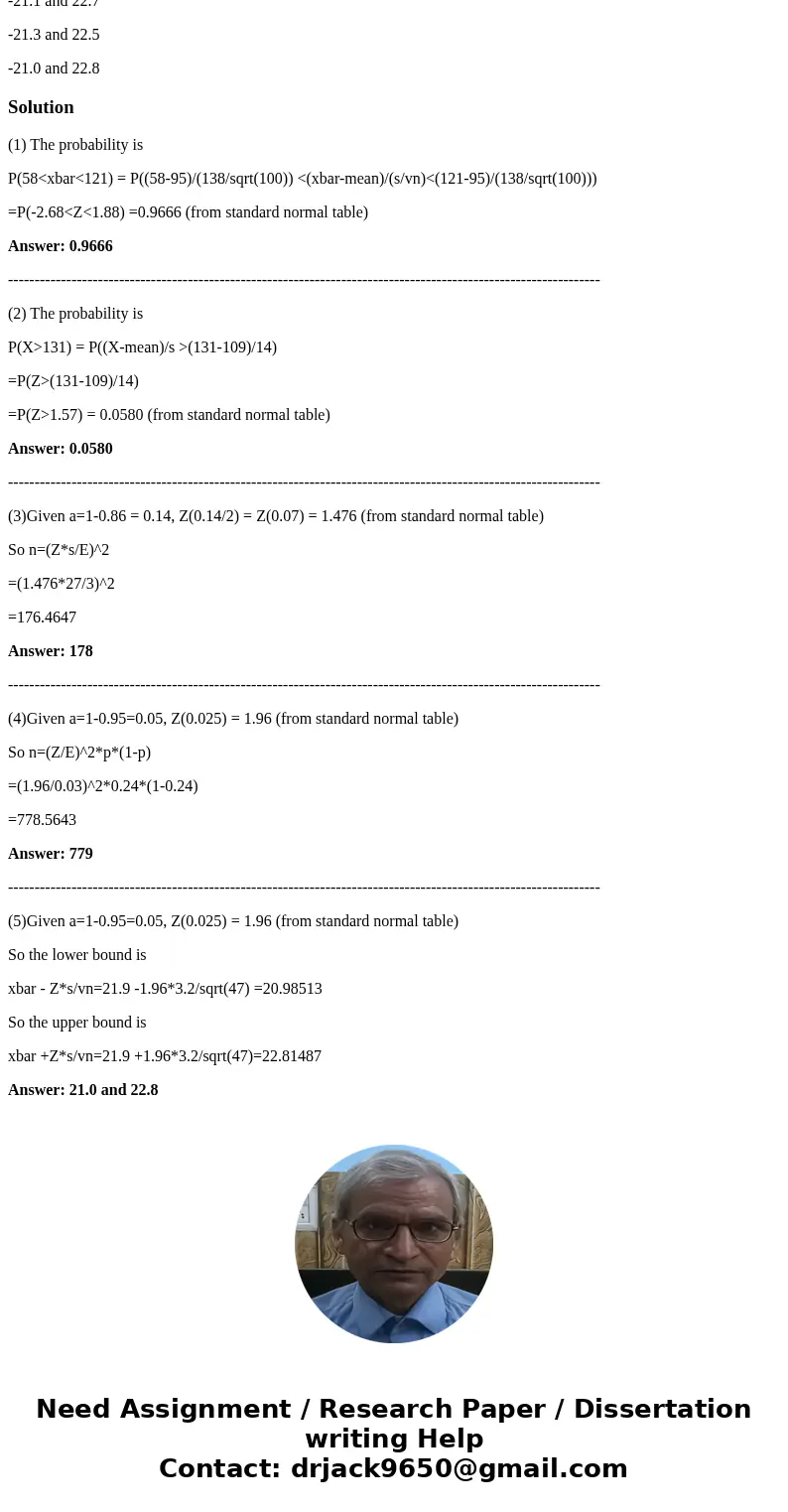1 An accounting firm is planning for the next tax preparatio
1.) An accounting firm is planning for the next tax preparation season. From last year\'s returns, the firm collects a systematic random sample of 100 filings. The 100 filings showed an average preparation time of 95 minutes with a standard deviation of 138 minutes. What is the probability that the mean completion time is between 1 and 2 hours, i.e., 58 and 121 minutes?
-Approximately 1
-0.9702
-0.9666
-0.4851
2.) The Intelligence Quotient (IQ) test scores are normally distributed with a mean of 109 and a standard deviation of 14. What is the probability that a person would score 131 or more on the test?
-0.4420
-0.9220
-0.0580
-0.9420
3.) The mean number of travel days per year for salespeople employed by hardware distributors needs to be estimated with a 0.86 degree of confidence. For a small pilot study the mean was 167 days and the standard deviation was 27 days. If the population mean is estimated within three days, how many salespeople should be sampled?
-538
-178
-2,138
-663
4.) The proportion of junior executives leaving large manufacturing companies within three years is to be estimated within 3 percent. The 0.95 degree of confidence is to be used. A study conducted several years ago revealed that the percent of junior executives leaving within three years was 24. To update this study, the files of how many junior executives should be studied?
-716
-779
-552
-1,349
5.) The mean weight of trucks traveling on a particular section of I-475 is not known. A state highway inspector needs an estimate of the mean. He selects a random sample of 47 trucks passing the weighing station and finds the mean weight is 21.9 tons. The population standard deviation is 3.2 tons. What is the 95 percent interval for the population mean? -22.0 and 23.8
-21.1 and 22.7
-21.3 and 22.5
-21.0 and 22.8
Solution
(1) The probability is
P(58<xbar<121) = P((58-95)/(138/sqrt(100)) <(xbar-mean)/(s/vn)<(121-95)/(138/sqrt(100)))
=P(-2.68<Z<1.88) =0.9666 (from standard normal table)
Answer: 0.9666
----------------------------------------------------------------------------------------------------------------
(2) The probability is
P(X>131) = P((X-mean)/s >(131-109)/14)
=P(Z>(131-109)/14)
=P(Z>1.57) = 0.0580 (from standard normal table)
Answer: 0.0580
----------------------------------------------------------------------------------------------------------------
(3)Given a=1-0.86 = 0.14, Z(0.14/2) = Z(0.07) = 1.476 (from standard normal table)
So n=(Z*s/E)^2
=(1.476*27/3)^2
=176.4647
Answer: 178
----------------------------------------------------------------------------------------------------------------
(4)Given a=1-0.95=0.05, Z(0.025) = 1.96 (from standard normal table)
So n=(Z/E)^2*p*(1-p)
=(1.96/0.03)^2*0.24*(1-0.24)
=778.5643
Answer: 779
----------------------------------------------------------------------------------------------------------------
(5)Given a=1-0.95=0.05, Z(0.025) = 1.96 (from standard normal table)
So the lower bound is
xbar - Z*s/vn=21.9 -1.96*3.2/sqrt(47) =20.98513
So the upper bound is
xbar +Z*s/vn=21.9 +1.96*3.2/sqrt(47)=22.81487
Answer: 21.0 and 22.8


 Homework Sourse
Homework Sourse